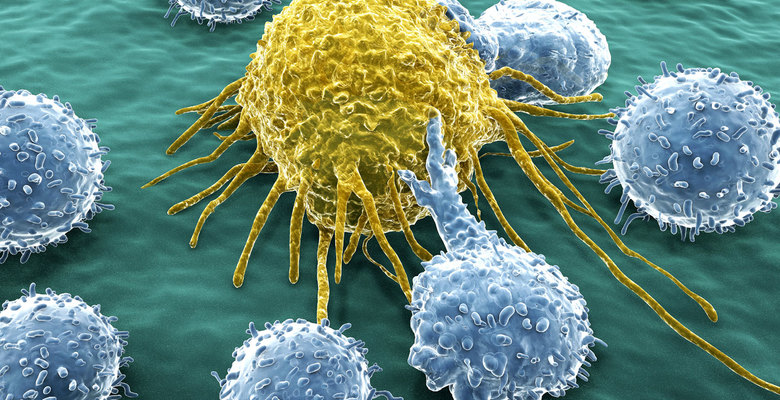
Forecasts made by science fiction writers rarely literally come true. But that’s exactly what happened to the story called “The Joke of Mother Nature” by Igor Rosokhovatsky. In the story a poor man is cured from cancer after eating a sweet potato infected by the sweet potato virus, while a wealthy guy dies despite being treated by the most advanced methods. The story was published in 1962. And in 2015 FDA authorized use of recombinant herpesvirus for the treatment of recurrent melanoma (skin cancer) and recombinant orthopoxvirus for the treatment of liver tumors.
Of course, the modern oncolytic viruses are not plant viruses. But we are witnessing the beginning of conscious use of viruses against oncology diseases; the method of destroying tumors with the help of viruses is being added to the list of cancer treatment methods.
Doubts and playing safe
The method cannot be considered new, as the first scientific article dedicated to it was published back in 1904. It described the use of the so-called “fixed” (weakened) strain of the rabies virus for treating oncology patients. But the method didn’t become popular due to the unpredictable nature of the results, as well as the fairly high degree of reactogenicity of the rabies vaccine of that time.
Nevertheless, researchers kept returning to this method throughout the XX century. Specifically, starting with the 1950s weak or non-pathogenic strains of the viruses of the West Nile fever, yellow fever, the rabies virus, adenoviruses, the Newcastle disease virus, enteroviruses, paramyxoviruses and some other non-pathogenic or slightly pathogenic viruses have been employed in various countries. In such treatment patients have occasionally fully recovered, sometimes the recovery was temporary. But again the lack of predictable results, scientifically explained principles of the effect viruses have on tumors and the warnings issued by the supervising institutions have led to an almost complete halt on the application of this approach.
In this country work in this direction was started in the 1970s by Prof. Voroshylova at the Institute for Poliomyelitis and Viral Encephalitis located near Moscow. In treating cancer patients she used vaccine strains of poliomyelitis virus and other strains of non-pathogenic enteroviruses, and in a number of cases she was very successful. But the prejudiced attitude of the leading oncologists led to a ban on her work.
Both in our country and in a number of other countries until recently the lack of trust towards the potentially useful anti-cancer viruses has been prevalent due to the fear of their pathogenic qualities. At the same time, doctors know very well that many chemotherapeutic drugs in fighting cancer have multiple harmful side effects. But they are used without causing any prejudice among physicians. The mechanism of action of the majority of such drugs is linked to the difference in metabolism in cancer and normal cells. Thus, such drugs hit on not only cancer, bus also some healthy cells, specifically, actively metabolizing dividing cells.
The first officially tested viral oncolytics
Since the 1990s there have appeared a much more theoretically valid concept f special oncolytic viruses. For the first time the researchers clarified the mechanism of what then was believed to be specific anti-cancer qualities of the deletionary variant of the firth type adenovirus called ONYX-015.
In human cells as well as in the cells of almost all mammals there is a protein p53, which with the onset of some unusual processes in the cell (including viral attack) launches the process of apoptosis ( pre-programmed cell death) to prevent the virus and the entire abnormal cell from multiplying. However, in many cancer cells p53 protein gene is damaged, while the protein itself become defective in this specific function; in such cells nothing prevents the multiplication of the virus.
But adenovirus in its turn has protein E1B-55K that ties up p53 and prevents it from launching apoptosis. Thus, we a part of the gene E1B where protein 55K is encoded is removed from the virus genome, such virus will multiply only in cancer cells, where p53 does not work anyway. In normal cells it will not be able to do that as the cells will be subject to apoptosis and destroy themselves.
However, as it became clear later in 2004 the removal of a part of the entire E1B gene would lead protein E1B-55K not performing a number of other functions for the multiplication of adenovirus. In cancer cells in its absence another unidentified factor takes upon itself this function. It has also became clear that there are many other defects in cells that lead to their transformation into cancer cells, in which case adenoviruses don’t work as therapy.
In late 1990s for a number of reasons this area of study became less popular. Nevertheless, an analog of ONYX-015, called Н101 (oncorin) was officially approved in China for the treatment of patients with head and neck tumors. Another recombinant adenovirus obtained in China also with the E1B gene deletion but with an addition of human p53 gene called Gendicine is currently being used there for treating oncology patients.
From 1998 to 2003 at the State Scientific Center for Virology and Biotechnology Vector the author of this article obtained a variant of adenovirus of the fifth serotype with completely removed E1B gene and partially removed E1A gene. The drug based on this virus was called Cancerolizin. It has been demonstrated that its strain is similar to the American ONYX-015 strain and the Chinese oncorin in its oncolytic properties.
That strain has gone through the complete cycle of preclinical trials headed by Vector’s Prof. Sergeyev. Based on the results of the trials Cancerolizin was approved for the 1st phase clinical trials, which were conducted in 2007 at Russia’s Blokhin Scientific Center for Oncology on eight volunteer patients. The trials revealed the patients’ tolerance for Cancerolizin, while in two cases therapeutic effect was observed despite the fact that all volunteer patients were at stage IV of disease development. Unfortunately, no financing was allocated for further trials back then, while later it became less meaningful due to the appearance of articles describing next generations of oncolytics.
New generation drugs
In 2010 the Novosibirsk State University received a grant for research headed by the famous Russian molecular biologist Chumakov, with the author of this article becoming one of the leading researchers on the grant work. The university set up from scratch a well-equipped research laboratory joined with a microbiology workshop. A number of overview articles on oncolytic viruses have been published. Back in 2012 first candidates for oncolytic strains were obtained and described.
By present time already outside of the grant work an informal group of researchers composed of employees of the Novosibirsk university, Vector and the Institute for Chemical Biology and Fundamental Medicine of the Siberian Chapter of the RAS have obtained a number of recombinant strains of the vaccinia virus with high oncolytic properties, which in in vivo models have demonstrated promising results. In addition, oncolytic strains of Sendai paramyxovirus have been described and registered and bacterial plasmids with a full-scale genome of the 6th serotype adenovirus have been constructed, which is very promising for obtaining new recombinant oncolytic strains with additions that improve the oncolysis of genes.
Thus, there is a good basis for conducting further work, specifically, for full-scale preclinical trials with subsequent clinical trials of these and similar oncolytic viral strains. Now is the time to overcome prejudice and give the green light for financing the development of such extremely promising drugs produced in Russia.
Work in this direction continues not only at the Novosibirsk University. Prof. Chumakov develops such research on enteroviruses and paramyxoviruses in his laboratory at the Institute for Molecular Biology of the RAS in Moscow. A number of Russian clinics are also interested in this work.
Can viruses be useful
In the last decade this area of work abroad has been developing fast. In October 2015 a radical shift took place in the USA regarding this area of research: as I have already mentioned, the FDA approved wide 3d Phase clinical trials of the gene-engineered strain of herpesvirus called Imlygic to treat patients with recurrent melanoma.
The original strain of herpesvirus, which contains attenuating genome mutations (that decrease its pathogenic characteristics) and the expressed human gene of granulocyte-macrophage colony-stimulating factor (GM-CSF), was developed by the US company BioVex Inc. In 2011 that company together with the rights to the drug was acquired by the pharmaceutical giant Amgen. That drug was officially approved for use in Europe in late 2015; the information about it is regularly updated at the website www.imlygic.com.
In the same year 2015 similar approval for Phase 3 clinical trials was granted for a drug based on recombinant strain of Pexa-Vec vaccinia virus (JX-594) for the treatment of hepatocellular carcinoma (liver cancer). That drug was developed on the basis of original strain of the Wyeth vaccinia virus with deleted thymidine kinase gene and added human GM-CSF gene to decrease its reactogenicity. It is currently being actively tested on volunteers. The results of several independent phase 1 and 2 clinical trials are already known and are positive. Thus, phase 3 clinical trials for this drug are taking place in dozens of countries in 86 hospitals, which shows how promising it is.
During the latest 17th International Virology Congress that took place in Singapore a lecture by Prof. Grant McFadden from the USA and two sections (Viruses as Trojan Horses and Viruses and Cancer) were dedicated to oncolytic viruses. Thus, interest for this area has grown immensely; it is being financed as never before in Canada, USA, Japan, Finland and other countries.
In this regard the question arises: can it be true that the role of at least some viruses for human body lies in protecting it from cancer cells and only occasionally they cause diseases by going rampant?
Such an idea deserves attention. Humankind has created a lot of useful things from what at first sight appears to be harmful substances and microbes. Viruses as drugs are very interesting as they are highly specific micro devices. Some of them we have already learned to apply for our needs as live vaccines, medication (for example, bacteriophages – bacterial viruses instead of antibiotics) as well as for selective fight against harmful insects.
Sergey Netyosov,
correspondent member of the RAS,
Novosibirsk State University








